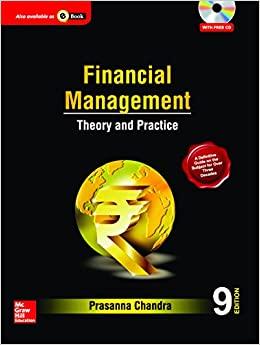Question
You have been asked to evaluate a potential acquisition of a smaller privately owned competitor. The acquisition candidate produces an EBITDA of 10% of your
You have been asked to evaluate a potential acquisition of a smaller privately owned competitor. The acquisition candidate produces an EBITDA of 10% of your current EBITDA and is offered to your firm at a price of multiple of 8 times EBITDA. Assume the following:
- Current debt costs you 8% and you can raise additional debt at this rate today. The loan is to be amortized over 7 years.
- Current return on equity is 15%
- Current WACC is 10%
- Tax rate is 30% (constant)
- 80% of the purchase price is considered depreciable assets to be depreciated over ten years on a straight-line basis with no residual values.
- Residual value for this operation is to be 2x current EBITDA in year ten.
Create an after-tax cash flow analysis to answer the following:
- Economic analysis: is this a fundamentally sound investment?
- Using the tax cash flows and no debt (pure equity), is the prospect a positive NPV using ROE as the hurdle rate?
- Is this project desirable? Explain how you came to this conclusion.
Part 4: Capital Structure Analysis and Funding Growth Strategies:
In Part 3, you completed a capital budget assessment for the purchase of a competitor business. Assume you found that this project to purchase a competitor will have a positive NPV and is desirable (regardless of your Part 3 calculations). The firm must raise financing for the acquisition project in the amount equal to 5% of the current level of its total assets. As you know, these funds can come from several sources: operations, short-term debt, long-term debt (new bond issues), or equity (new stock issues).
Your task is to decide where funds for this acquisition project should come from based on your knowledge of the firm and your knowledge of the current state of the economy (i.e., level of interest rates, state of the stock market, future prospects for the economy/firm). Your analysis should answer the following questions:
- How much must your firm raise for the investments to be undertaken?
- How will you determine where the funds should come from? Provide analysis for the following areas:
- Current capital structure of the firm, specifically, you must cite how some of the ratios you calculated in Part II will influence your decision.
- Federal Reserve policy and interest rates, meaning what are current borrowing interest rates and what direction do you believe these will trend in the near future?
- Stock price and state of the stock market, meaning are current stock prices high? Low? How could a firms financing choice(s) be impacted?
current ebitda 9,218 million ANY HELP PLEASE
You have been asked to evaluate a potential acquisition of a smaller privately owned competitor. The acquisition candidate produces an EBITDA of 10% of your current EBITDA and is offered to your firm at a price of multiple of 8 times EBITDA. Assume the following:
- Current debt costs you 8% and you can raise additional debt at this rate today. The loan is to be amortized over 7 years.
- Current return on equity is 15%
- Current WACC is 10%
- Tax rate is 30% (constant)
- 80% of the purchase price is considered depreciable assets to be depreciated over ten years on a straight-line basis with no residual values.
- Residual value for this operation is to be 2x current EBITDA in year ten.
Create an after-tax cash flow analysis to answer the following:
- Economic analysis: is this a fundamentally sound investment?
- Using the tax cash flows and no debt (pure equity), is the prospect a positive NPV using ROE as the hurdle rate?
- Is this project desirable? Explain how you came to this conclusion.
Part 4: Capital Structure Analysis and Funding Growth Strategies:
In Part 3, you completed a capital budget assessment for the purchase of a competitor business. Assume you found that this project to purchase a competitor will have a positive NPV and is desirable (regardless of your Part 3 calculations). The firm must raise financing for the acquisition project in the amount equal to 5% of the current level of its total assets. As you know, these funds can come from several sources: operations, short-term debt, long-term debt (new bond issues), or equity (new stock issues).
Your task is to decide where funds for this acquisition project should come from based on your knowledge of the firm and your knowledge of the current state of the economy (i.e., level of interest rates, state of the stock market, future prospects for the economy/firm). Your analysis should answer the following questions:
- How much must your firm raise for the investments to be undertaken?
- How will you determine where the funds should come from? Provide analysis for the following areas:
- Current capital structure of the firm, specifically, you must cite how some of the ratios you calculated in Part II will influence your decision.
- Federal Reserve policy and interest rates, meaning what are current borrowing interest rates and what direction do you believe these will trend in the near future?
- Stock price and state of the stock market, meaning are current stock prices high? Low? How could a firms financing choice(s) be impacted?
Step by Step Solution
There are 3 Steps involved in it
Step: 1

Get Instant Access to Expert-Tailored Solutions
See step-by-step solutions with expert insights and AI powered tools for academic success
Step: 2

Step: 3

Ace Your Homework with AI
Get the answers you need in no time with our AI-driven, step-by-step assistance
Get Started


